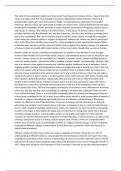Essay
WJEC Criminology Unit 1 AC3.1, AC3.2, AC3.3 Model Answer
- Module
- Changing Awareness of Crime
- Institution
- WJEC
Model Answer for WJEC Criminology Unit 1: Changing Awareness of Crime, AC3.1, AC3.2 and AC3.3. In my Unit 1 exam I got full marks. Please put into your own words to avoid being penalised/use to help you understand what the question requires or to plan your own answer. Any mention to the brief needs...
[Show more]






